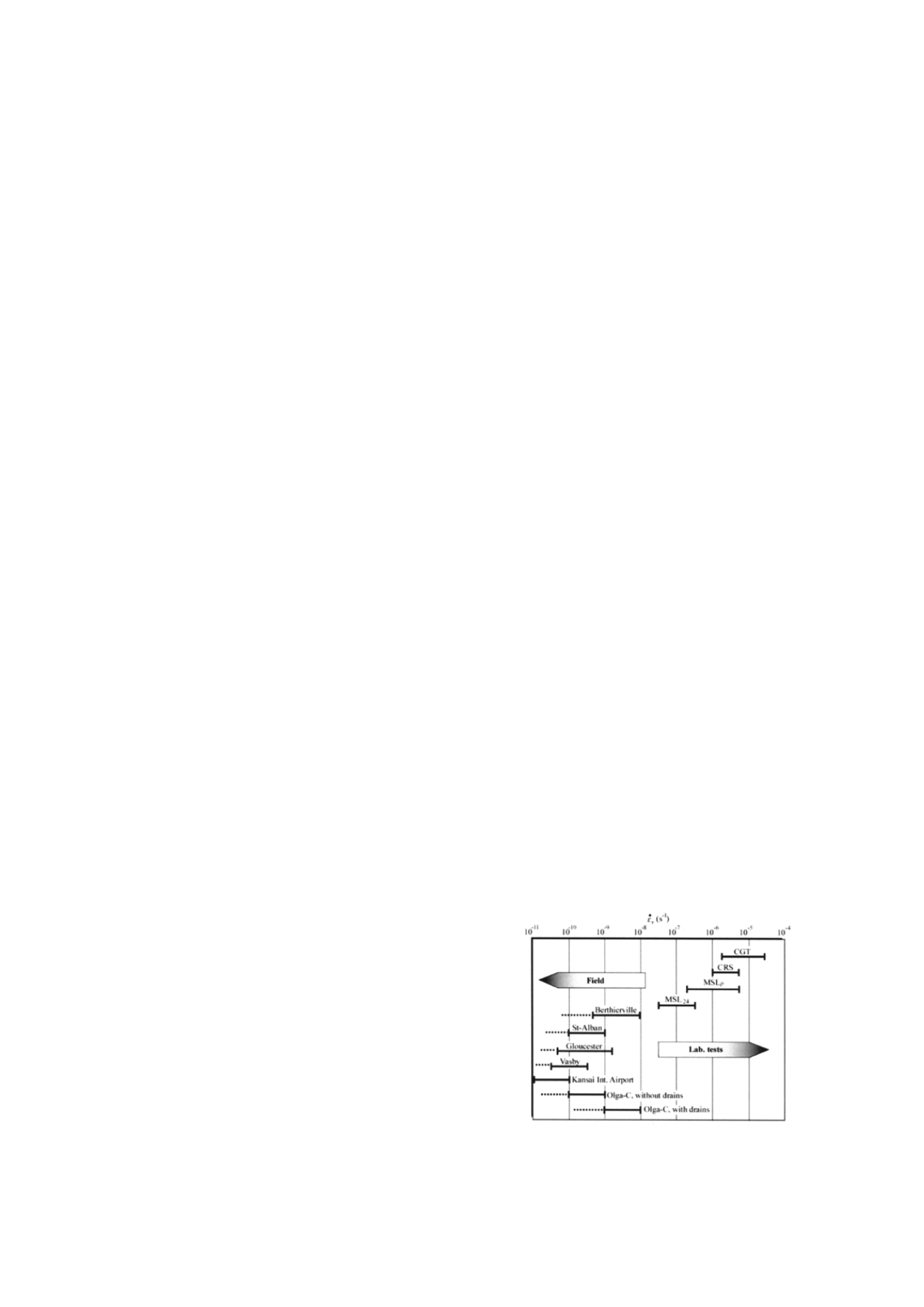
235
Creep characteristics of clay in one-dimensional compression with
unloading/reloading cycles
Propriétés de fluage des argiles en compression unidimensionnelle avec cycles de
charge/décharge.
Kawabe S., Tatsuoka F.
Tokyo University of Science, Japan
ABSTRACT: One-dimensional compression tests including sustained loading stages were performed on reconstituted specimens of
two types of clay. In some tests, a number of sustained loading tests were performed during otherwise multiple unloading/reloading
cycles with relatively large stress amplitudes. The creep strain taking place at respective sustained loading stages is a function of the
ratio of the current sustained loading stress to the stress at which the latest reversal of loading direction was made, independent of
previous loading history and current sustained loading stress. A new laboratory one-dimensional compression test method is proposed
to evaluate the creep process at such very low strain rates as observed in the field. Creep processes until the creep strain rate becomes
as small as about 10
-10
%/sec can be observed by this method. This new method is much less time-consuming than sustained loading
tests starting from the primary loading.
RÉSUMÉ : Des essais oedométriques avec fluages ont été réalisés sur deux types d’argiles remaniées. Pour certains essais, des
fluages ont ete appliqués lors de grands cycles de chargement comprenant de multiples charges/décharges. Les déformations de fluage
observées sont fonction uniquement du rapport entre l’ état de contrainte actuel appliqué et l’ état de contrainte appliqué lors de la
dernière inversion de chargement. Elles restent ainsi indépendantes de l’histoire précédant la dernière inversion et de la seule valeur
de la contrainte actuelle. Une nouvelle procédure expérimentale est ainsi proposée pour étudier de manière plus précise les
déformations de fluage, jusqu'à des valeurs extrêmement faibles (10
-10
%/sec) telles que mesurées in situ. La procédure proposée a
l’avantage d’écourter grandement la durée du chargement comparativement à des essais classiques de fluage réalisés lors d’une
première charge.
KEYWORDS: Clay, One-dimensional compression test, Creep, Strain rate, Loading/unloading/reloading.
1 INTRODUCTION
Most of the previous studies on long-term residual compression
of soft clay were focused on the behaviour during primary
loading under the normally consolidated conditions. Despite
strong geotechnical engineering needs, the study under general
loading conditions, not only primary loading but also unloading
(UL), reloading (RL) and cyclic loading (UL/RL), is very
limited (e.g., Acosta Martínez et al. 2005; Kawabe et al., 2009).
Besides, the concerned elapsed time under constant load after
the end of construction in a full-scale soft clay deposit is usually
very long. Therefore, the residual strain rates are very low,
significantly lower than those in ordinary laboratory tests
(Figure 1). Consequently, the field residual deformation can be
predicted from ordinary laboratory test results only when based
on a relevant theoretical framework that can simulate the creep
behaviour at very low strain rates as in the field. However,
laboratory tests to validate such a frameworks as above take
extremely long time when sustained loading is performed until
the strain rate reaches typical values in the field or when
constant-rate-of-strain (CRS) tests are performed at typical
strain rates in the field (Tanaka, 2005).
In view of the above, Kawabe et al. (2011) performed a
series of one-dimensional (1D) compression tests including
multiple unloading/reloading (UL/RL) cycles with many
sustained loading (SL) stages on disc-shaped specimen (
60
mm ×
h
20 mm, Figure 2) made by trimming a large clay cake.
The inside face of the ring was smeared with a grease layer to
decrease the friction. Although the apparatus was relatively
simple, CRS tests could be conducted by means of a feed-back
and automated pneumatic loading system. Figure 3 summarises
the relationships between the creep strain during sustained
loading (SL) for three hours and the ratio of the stress at the
start of unloading (UL) or reloading (RL) at an axial strain rate
equal to ± 0.005 %/min,
UL
or
RL
, to the stress at SL,
SL
.
The creep strain rates during otherwise UR and RL are smaller
than those during otherwise primary loading and become very
small or even negative depending on loading history. Besides,
positive and negative creep strains are a unique function of,
respectively, the loading stress ratio,
SL UL
/
(i.e., over-
consolidation ratio,
OCR
) and
SL
RL
/
, not by the stress
difference,
SL
UL
and
SL
RL
. This relation is also a
function of other factors. For example, the creep strain increases
with an increase in the initial strain rate (i.e., the strain rate
during the CRS loading immediately before the concerned SL
stage) and the elapsed time during the SL stage.
In this study, to confirm the generality of the empirical
relations described in Figure 1, another series of 1D
compression tests including multiple UL/RL cycles with many
SL stages were performed. Based on the test results, a new test
method to observe creep behaviours at very low strain rates in a
relatively short time is proposed.
Figure 1. The strain rate measured in laboratory and in situ (Leroueil
2006)
1


